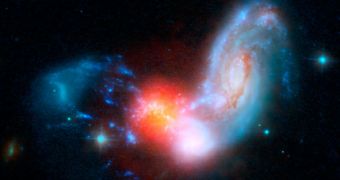Scientists operating the Spitzer Space Telescope announce that they recently managed to capture an impressive new view of an area of intense stellar formation in the system II Zw 096, which is made up of two colliding galaxies.
This type of mergers is known for producing spectacular vistas. As two galaxies cannibalize each other, the hydrogen gas they contain is stirred and channeled into massive stellar nurseries, which then begin producing new stars at a frantic pace.
Such a structure is the one recently imaged by Spitzer. Astronomers say it stood out simply because it emitted as much infrared light as an entire galaxy, regardless of the massive shroud of cosmic dust enveloping it.
Observatories operating in other wavelengths of light cannot see this stellar nursery despite its brightness in the infrared portion of the electromagnetic spectrum.
According to experts, the new image shows the most luminous nursery located elsewhere in a galaxy other than at the core. It is brighter than even the famous off-nuclear starburst in the Antennae Galaxy.
Typically, researchers say, hydrogen gas accumulates at the core of colliding galaxies, but apparently the outer regions have massive star-forming potential as well.
“This discovery proves that merging galaxies can generate powerful starbursts outside of the centers of the parent galaxies,” explains astronomer Hanae Inami, a graduate student at The Graduate University for Advanced Studies, in Japan.
Inami, who is the first author of a new paper detailing the findings, also holds an appointment with the Spitzer Science Center, which is based at the California Institute of Technology, in Pasadena.
The Spitzer research is detailed in a paper appearing in the July issue of the esteemed Astronomical Journal.
“The infrared light emission of the starburst dominates its host galaxy and rivals that of the most luminous galaxies we see that are relatively close to our home, the Milky Way,” adds Inami.
“No matter how you slice it, this starburst is one of the most luminous objects in the local Universe,” adds the second author of the paper, Spitzer Science Center senior research astronomer Lee Armus.
The starburst can be seen some 500 million light years away from Earth, in the direction of the constellation Delphinus (the Dolphin), the team concludes.

 14 DAY TRIAL //
14 DAY TRIAL //